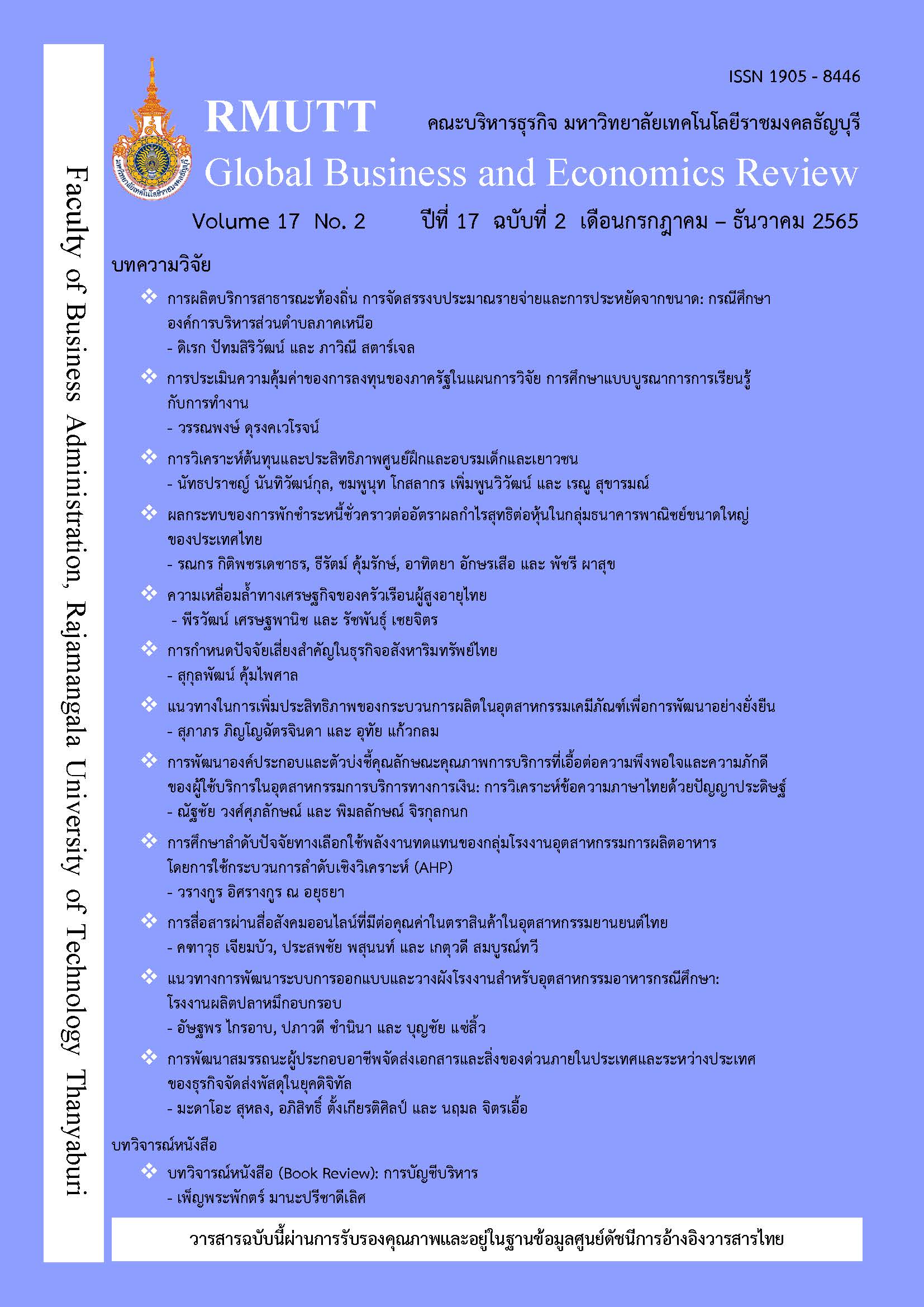THE COST AND EFFICIENCY ANALYSIS OF JUVENILE VOCATIONAL CENTER
Keywords:
Cost Analysis, Cost Per Units, Economy of Scale, Juvenile OffenderAbstract
The objectives of this research are as follows: 1) an analysis of cost; and 2) an analysis of economy of scale. This study uses a mixed research method that consists of quantitative and qualitative research. The study uses 2 data sets from the Juvenile Vocational Center: 1) the data related to the monthly costs of 17 Juvenile Vocational Centers according to governmental accounting from September 2016 to December 2019, with a total of 680 samples from 16,000 youths; and 2) group discussions are qualitative data collection tools. The data is collected from 30 observation subjects in 4 centers. The total cost equations are estimated using econometric methods. The results reveal that an economy of scale does not appear within the operations of small and large centers. An inefficient resource allocation occurs in large centers. The minimum long-term average cost is 5,400 baht, about 500 youths. This cost is inappropriate for the workload as it is lower than the average standard living cost. The authority should allocate a budget for the center by using a minimum average cost of a small center.
References
กรมพินิจและคุ้มครองเด็กและเยาวชน. (2563). รายงานผลการดำเนินงานของรัฐต่อสาธารณะรายปี ประจำปีงบประมาณ พ.ศ. 2562. กรุงเทพฯ: กรมพินิจและคุ้มครองเด็กและเยาวชน.
เฉลิมพล แจ่มจันทร์, สุภรต์ จรัสสิทธิ์ และ ณัฐณิชา ลอยฟ้า. (2562). ต้นทุนการเลี้ยงดูบุตร(อายุ 0-14 ปี) ในประเทศไทย. วารสารเศรษฐศาสตร์ มหาวิทยาลัยเชียงใหม่, 23(1), 55-78.
ธรรณพร คชรัตน์ สบายใจ และ วีระเทพ ปทุมเจริญวัฒนา. (2562). การพัฒนาระบบสนับสนุนและเสริมสร้างศักยภาพเด็กและเยาวชนในกระบวนการยุติธรรมแบบมีส่วนร่วม. กรุงเทพฯ: สำนักงานกองทุนสนับสนุนการวิจัย.
พงษ์เทพ สันติกุล. (2560). การวิเคราะห์ต้นทุน ประโยชน์โครงการพัฒนาระบบการบำบัดแก้ไขฟื้นฟูเด็กและเยาวชนเฉพาะรายแบบไร้รอยต่อ. วารสารการเมือง การบริหาร และกฎหมาย, 9(3), 613-643.
พัชรา สินลอยมา, นัทธปราชญ์ นันทิวัฒน์กุล, ธเนศ เกษศิลป์ และ มุทิตา มากวิจิตร์. (2560). การเปลี่ยนแปลงกระบวนทัศน์ของเด็กและเยาวชนไทยที่กระทำผิดซ้ำเพื่อเสริมสร้างความตระหนักในคุณค่าของชีวิตก่อนคืนสู่สังคม. กรุงเทพฯ: สำนักงานกองทุนสนับสนุนการวิจัย.
สำนักงานสถิติแห่งชาติ. (2563). สำรวจภาวะเศรษฐกิจและสังคมของครัวเรือน พ.ศ. 2562. สืบค้นจาก http://www.nso.go.th/sites/2014/Pages
อาภาพงศ์ กฤตเวทิน. (2551). มาตรฐานการดำเนินงานและการปฏิบัติต่อเด็กและเยาวชนที่กระทำผิดของกรมพินิจและคุ้มครองเด็กและเยาวชน. กรุงเทพฯ: กรมพินิจและคุ้มครองเด็กและเยาวชน.
Aizer, A., & Doyle, J. J. (2015). Juvenile incarceration, human capital and future crime: evidence from randomly-assigned judges. Quarterly Journal of Economics, 130(2), 759–803. doi:https://doi.org/10.1093/qje/qjv003.
Barquín, J., Cano, M. Á., & Calvo, M. d. l. Á. (2019). Treatment, reintegration, and quality of prison life: perception by inmates.
International Journal of Offender Therapy and Comparative Criminology, 63(13), 2291–2317. doi:DOI: 10.1177/0306624X19851669.
Belfield, C. R., Levin, H. M., & Rosen, R. (2012). The economic value of opportunity youth. Michigan: W.K. Kellogg Foundation for the Corporation for National and Community Service.
Carlton, D. W., & Perloff, J. M. (2002). Modern industrial organization (3rd ed.). Chicago: Addison-Wesley.
Carter, A. (2019). The consequences of adolescent delinquent behavior for adult employment outcomes. Journal of Youth and Adolescence, 48, 17–29.
Ginneken, E. F. J. C. V., Sutherland, A., & Molleman, T. (2017). An ecological analysis of prison overcrowding and suicide rates in England and Wales, 2000–2014. International Journal of Law and Psychiatry, 50, 76–82. doi:http://dx.doi.org/10.1016/j.ijlp.2016.05.005.
Hennebel, V., Simper, R., & Verschelde, M. (2017). Is there a prison size dilemma? An empirical analysis of output-specific economies of scale. European Journal of Operational Research, 262(1), 306-321.
Martin, J. (2016). prisoner population and trends –discussion paper. Dublin: The Management Board of the Department of Justice and Equality.
Nicholson, W. (1998). Microeconomic theory: basic principles and extension (7th ed.). Fort Worth: Harcourt, Inc.
The Michigan Council on Crime and Delinquency (2011). Michigan youth reentry model building a reentry framework for youth, families and communities. Michigan: The Michigan Committee on Juvenile Justice and the Office of Juvenile Justice and Delinquency Prevention.
Turner, H. C., Turrner, J., Hollingsworth, T. D., & Anderson, R. M. (2017). Economic evaluations of mass drug administration: the importance of economies of scale and scope. Clinical Infectious Diseases, 66(8), 1-6.
UNODC. (2015). United Nations standard minimum rules for the treatment of prisoners (the Nelson Mandela Rules). Austria: Justice Section, Division for Operations.
Washington State Institute for Public Policy (2004). Outcome evaluation of Washington State's research-based programs for juvenile offenders. (04-01-1201). Olympia: Washington State Institute for Public Policy.
Downloads
Published
How to Cite
Issue
Section
License
Copyright (c) 2022 นัทธปราชญ์ นันทิวัฒน์กุล, ชมพูนุท โกสลากร เพิ่มพูนวิวัฒน์, เรณู สุขารมณ์

This work is licensed under a Creative Commons Attribution-NonCommercial-NoDerivatives 4.0 International License.
The articles published in this journal are the intellectual property of their respective authors.
The views and opinions expressed in each article are solely those of the individual authors and do not reflect the positions of Rajamangala University of Technology Thanyaburi or any of its faculty members. All components and content of each article are the sole responsibility of the respective authors. In the event of any errors, the authors shall bear full responsibility for their own work.








